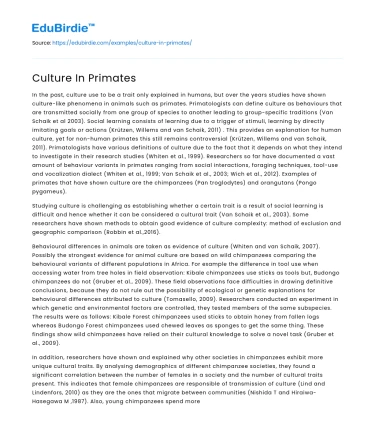In the past, culture use to be a trait only explained in humans, but over the years studies have shown culture-like phenomena in animals such as primates. Primatologists can define culture as behaviours that are transmitted socially from one group of species to another leading to group-specific traditions (Van Schaik et al 2003). Social learning consists of learning due to a trigger of stimuli, learning by directly imitating goals or actions (Krützen, Willems and van Schaik, 2011) . This provides an explanation for human culture, yet for non-human primates this still remains controversial (Krützen, Willems and van Schaik, 2011). Primatologists have various definitions of culture due to the fact that it depends on what they intend to investigate in their research studies (Whiten et al., 1999). Researchers so far have documented a vast amount of behaviour variants in primates ranging from social interactions, foraging techniques, tool-use and vocalization dialect (Whiten et al., 1999; Van Schaik et al., 2003; Wich et al., 2012). Examples of primates that have shown culture are the chimpanzees (Pan troglodytes) and orangutans (Pongo pygameus).
Studying culture is challenging as establishing whether a certain trait is a result of social learning is difficult and hence whether it can be considered a cultural trait (Van Schaik et al., 2003). Some researchers have shown methods to obtain good evidence of culture complexity: method of exclusion and geographic comparison (Robbin et al.,2016).
Save your time!
We can take care of your essay
- Proper editing and formatting
- Free revision, title page, and bibliography
- Flexible prices and money-back guarantee
Behavioural differences in animals are taken as evidence of culture (Whiten and van Schaik, 2007). Possibly the strongest evidence for animal culture are based on wild chimpanzees comparing the behavioural variants of different populations in Africa. For example the difference in tool use when accessing water from tree holes in field observation: Kibale chimpanzees use sticks as tools but, Budongo chimpanzees do not (Gruber et al., 2009). These field observations face difficulties in drawing definitive conclusions, because they do not rule out the possibility of ecological or genetic explanations for behavioural differences attributed to culture (Tomasello, 2009). Researchers conducted an experiment in which genetic and environmental factors are controlled, they tested members of the same subspecies. The results were as follows: Kibale Forest chimpanzees used sticks to obtain honey from fallen logs whereas Budongo Forest chimpanzees used chewed leaves as sponges to get the same thing. These findings show wild chimpanzees have relied on their cultural knowledge to solve a novel task (Gruber et al., 2009).
In addition, researchers have shown and explained why other societies in chimpanzees exhibit more unique cultural traits. By analysing demographics of different chimpanzee societies, they found a significant correlation between the number of females in a society and the number of cultural traits present. This indicates that female chimpanzees are responsible of transmission of culture (Lind and Lindenfors, 2010) as they are the ones that migrate between communities (Nishida T and Hiraiwa-Hasegawa M ,1987). Also, young chimpanzees spend more time of their lives with their mothers than fathers (Boesch and Boesch, 1990). The role of female orangutans in being the carriers of orangutan culture has not been cited in literature.
Lots of research has focused on culture in chimpanzees, 39 behavioural variants have been considered a cultural variant (Whiten et al., 1999). Yet there are studies showing orangutans also exhibiting culture. A study has shown orangutans to have evidence for cultural transmission of 24 behaviours; using leaves as protection gloves, using sticks to poke into tree holes to get insects and snag-riding (ride falling trees in which food would be grabbed from before the tree hits the ground)(Van schaik et al., 2003). Also, orangutans have been observed feeding on Neesia fruit in two different sites. Observations have shown at one site orangutans used sticks to obtain seeds whereas on the other site no use of tools reported, despite both sites having similar habitats (Van and Knott,2001). These findings are compatible with those on chimpanzees, particularly studies on nut cracking with stone tools (Boesch et al., 1994; McGrew et al., 1997). Furthermore, there are activities all orangutans do but where different groups do it differently. For example, all orangutans build nests in the forest canopy but each group has its own way of building it: some make pillows and others put roofs over nests (Van schaik et al .,2003).
Similarly, leaf sponging in chimpanzees is considered a universal behaviour but there is variation in how the technique is used in chimpanzee communities (Sousa, Biro and Matsuzawa, 2009) Moreover, the first behaviour to be considered a cultural trait in chimpanzees was the grooming handclasp (McGrew and Tutin, 1978). This behaviour was analysed later by researchers to increase its validity as a cultural trait of chimpanzees and to shed light on the extent in which this behaviour varies between groups of chimpanzees. Observations have portrayed chimpanzees that are genetically similar in neighbouring communities exhibit different grooming handclasp techniques. One group used a palm to palm technique and another used wrist to wrist. These findings cannot be fully explained by ecological or genetic factors and that the relative arm lengths of grooming individuals did not correlate with such differences (van Leeuwen et al., 2012).






 Stuck on your essay?
Stuck on your essay?

